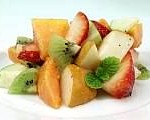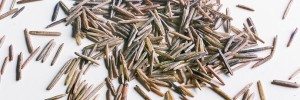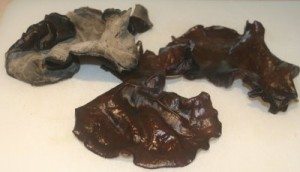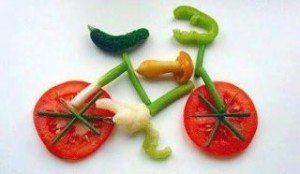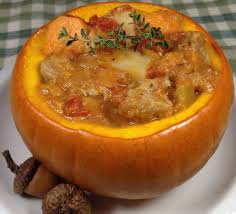The phrase “Eat healthy” more than likely creates a visual of fruits and vegetables in most people’s minds. Even I, in my office, have a poster that recommends “Eat a Rainbow” today. The poster represents a rainbow made from food, from red beets and tomatoes, to green leafy vegetables, yellow squash, bright orange papaya and even purple eggplant. Many of us actually do eat this way, but we also tend to throw away the parts of our rainbow that could offer a greater nutritional value than the parts we actually eat.
A phytochemical is defined as a compound found in plant-based foods that may improve health. The layman explanation I like to use is the power of “superfoods.” These compounds are often found in the cellulose fiber of the pits, seeds, stems, skin and rinds, the parts most of us dispose.
So here is why we should reconsider what to put in the pot or what to put in the disposal and you may be surprised at the new emerging flavors, over and above the increased health benefits.
These phytochemicals are actually edible. In some cases, it is just a matter of breaking down the fibrous tissue in an appropriate cooking manner. In others, it may require some creativity to put the entire garden to work. I have selected a few examples that I find interesting:
It amazes me how many people are unfamiliar with the natural state of broccoli, because it is often sold in frozen floret form. The stalk is just as edible as the florets and can be shaved with a vegetable peeler into ribbons, garnished with orange or lemon zest from the peels of citrus fruit, add strips of Parmesan and Reggiano cheese to offer a delicious gourmet salad. (Notice how I slid in the citrus peel, as it too is a good example of “dispose of or dine on”). So what is the deal? Did you know that one broccoli stalk has almost double the daily required amount of Vitamin C? Furthermore, it has a significant amount of Fiber. Beta-carotene (pre cursor for Vitamin A,) iron, even some calcium and the phytochemicals indoles and aromatic isothiocynates. Technical food terminology that in layman’s terms, means superfoods.
With an A + on the nutritional report, these stems play a role in boosting certain enzymes that help to detoxify the body which in turn helps to prevent cancer, diabetes, heart disease, osteoporosis, and high blood pressure.
Over and above the nutrition, most health conscious people are concerned that healthy food tends to cost more. Just imagine how much more value you can get from the whole broccoli plant if you were not disposing of the stalks.
Have you ever tried to salt and roast your watermelon seeds? (Don’t forget to dry them out first). This may seem like a lot of work to save very little space in the garbage bin. However, other than the tons of fiber offered, one ounce of dried watermelon seeds contains about 3 grams of zinc (25 % of Daily Recommended amount), and 2 grams of iron (14 % of daily recommended amount). Be aware however, that humans cannot gain the nutritional value out of the whole seed, so unless you chew them, it will be “seeds today, seeds tomorrow.”
And then there are the rinds to consider. If you use fruit rinds in a mishmash of other otherwise disposed of vegetable pieces, like Swiss Chard stems, eggplant tops, onion skins, zucchini and carrot trimmings, celery stalks and potato skins, you can make a stock great for soup base, cooking grains in, and adding some interest to stir fried veggies.
Celery leaves have a compound called phthalides, which has been shown to play a role in relaxing arteries, and thus may help lower blood pressure. Celery stalks also have one of the highest sources of fiber in a plant, which therefore offers invaluable benefits to the digestive tract health which in turn aids in immunity.
One creative way to reap these benefits is to perhaps make celery salt. It will have a strong flavour but remain light and fluffy in texture. Place the leaves on a sheet pan. After using the oven for something else you can make use of the residual heat to dry out the leaves. This enables all the excess moisture removal without yellowing or browning the leaves. Finely crumble the dried leaves into tiny pieces. Now grind these together with sea salt and some celery seed (about 1.5 parts sea salt to 1 part celery seed with a pinch of celery seeds). The classic use is in a Bloody Mary, but also can turn a boring tuna salad into a delicacy.
Another fine idea is to combine with finely chopped carrot and fennel leaves and mix into a homemade salsa of chopped tomato, onion and cilantro.
Papaya fruit is known for its antioxidants. But did you know the seeds are also rich in a phytochemical called Papain. Papain is similar to a digesting enzyme which will strengthen immunity and destroy cancer cells over and above the antioxidant content. The enzyme action destroys viruses, allergens and the coating of fungi before they can destroy human cells. Papaya seeds also contain fibrin, which reduces the risk of stroke by reducing blood clot potential.
A warning about papaya seeds is however necessary too: some seeds may have a minute amount of cyanogens (cyanide producing agent). The American Poison control centers can be contacted for updated information on any produce for warning levels.
To reduce the pungency of papaya seeds, they can be blended into a delicious drink with the papaya skin, almond milk, some ginger, and either honey or agave to add sweetness.
Onion Skins
Not only do onion skins have antioxidants, but they also are known for a flavanoid called Quercetin. A flavanoid is what gives plants their coloring, and may also offer phytochemical benefits. In this case, onion skins are protective against cardiovascular disease and various cancers. Furthermore, Quercetin is a sulphurous compound, meaning it has some form of sulphur in its chemical make-up.Sulphuritself is a pharmaceutical antioxidant. Sulphurous compounds are also characteristic of its odor, giving onion an unmistakable identity. This may be a downside to the nose, but this is outweighed by its anti-inflammatory ability. Onion skins are also rich in fructans. Fructan produces good bacteria (prebiotics) which aid in gut health. The prebiotic Inulin is a fructan, which being a polymer of fructose molecules, also offer an identifiable sweetness making it easy to use for various recipes. One creative idea is to use onion skins as an infusion (tea).
Other great nutrients worth a mention
I can go on forever, giving great examples. Worth mentioning is firstly, Swiss chard leaves because they are rich in the pleasure centers of the nervous system and simulate the neurotransmitter dopamine. They are also a good source of glutamine known for benefits in joint health. Right there, the benefits of avoiding anti-depressant medication and living a pain free lifestyle is evident. Secondly, turnip leaves outweigh any cruciferous vegetable in their nutrient content, regardless that cruciferous variety is known for calcium and folate content. Beet tops are richer in antioxidants, fiber, calcium and iron than the root itself.
Remember all of these, as well as melon rinds, potato peels, cob of the corn, and radish leaves, as well as the ones keynoted above, can be used to create a stock used for making great soups. Braising is a cooking method, which can break down the more fibrous material leaving you with an edible product, as well as a flavorful addition to stews and casseroles, or even poach fish in, add to a risotto, or to add flavor by cooking grains in it. Some ideas for the more fruit leaves and rinds include making rich and tart jams, or jellies, or even salad dressing type vinaigrettes by boiling them with vinegar, water, salt and stock. Mix with additions like chopped almonds and raisins and your guests will be begging you for these healthful, nutritious and delicious recipes.
Summary
The edible part of a plant-based food starts at the sprouts or root and ends at the tip of the leaves or shoots, taking the vines, tubers, and shoots along with it. So for those of you either wanting to get a whole lot more bang for your buck, especially those that tend to spend more on health foods that are grown from the earth, or for those home cooks wanting to experiment with a wider range of flavor and technique, put the entire garden to work. Not only will your dollar go further, but you will gain a nutrient benefit more than often unnecessarily lost to the garbage.
REFERENCES:
Smith, Lombard, Peffley, Liu. Genetic Analysis of Quercetin in Onion (Allium cepa L.)‘Lady Raider.’TheTexasJournal of Agriculture and Natural Resource 16:24-28 (2003)
Harborne, J.B. 1986. Nature, distribution and function of plant flavonoids, p. 15-24.
In Cody, V., E. Middleton, Jr. and J.B. Harborne (eds.). Progress in Clinical and Biological Research, Vol.213. Alan R. Liss,New York.
Herrmann, K. 1976. Flavonols and flavones in food plants: a review. Journal of FoodTechnology 11:433-448.
Keli, S.O., M.G.L. Hertog, E.J.M. Feskens, and D. Kromhout. 1996. Dietary flavonoids,
antioxidant vitamins, and incidence of stroke. Arch Intern. Med. 154: 637-642.
Two Minutes to Dinner: a Purple Kale Kitchenworks blog. Rona Welsh. Professional chef and journalist. Accessed July, 2011.
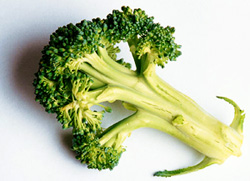

![celery salt]](http://192.185.164.20/wp-content/uploads/2011/08/celery-salt-300x300.jpg)


